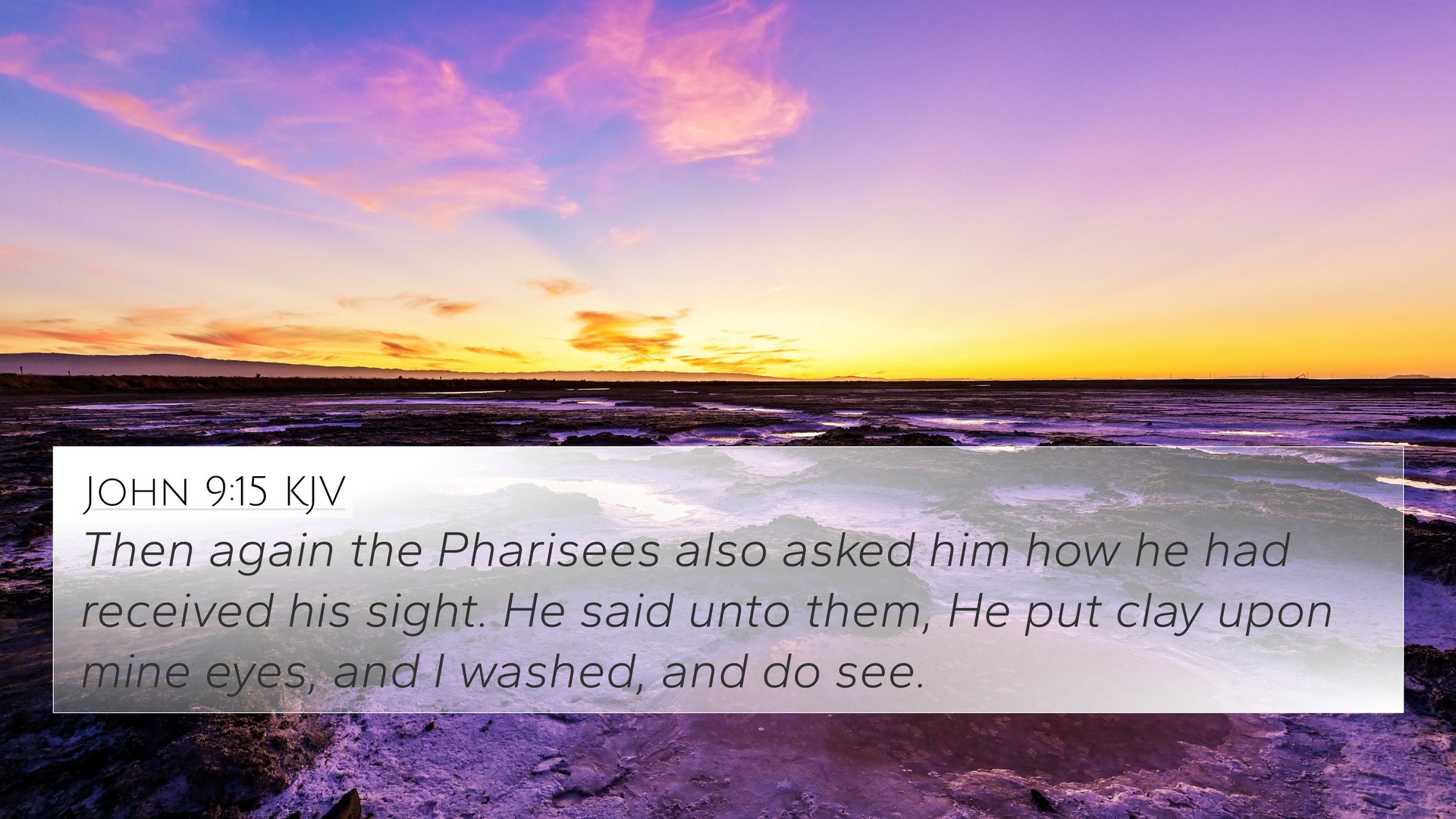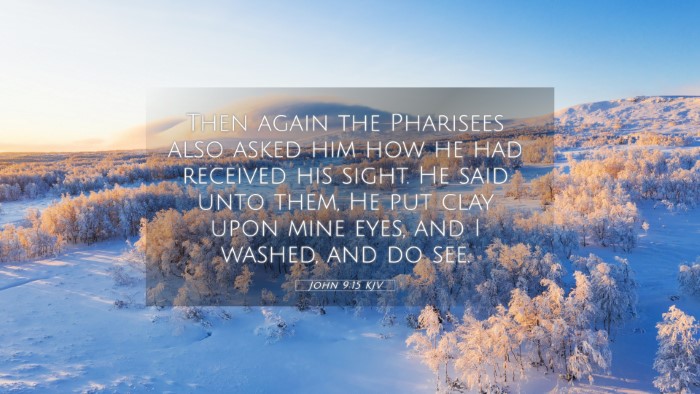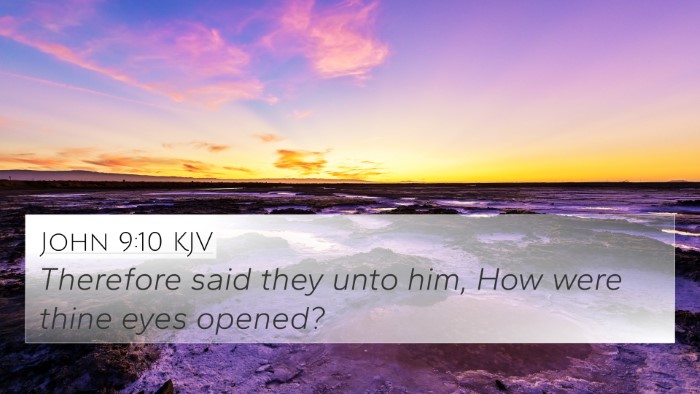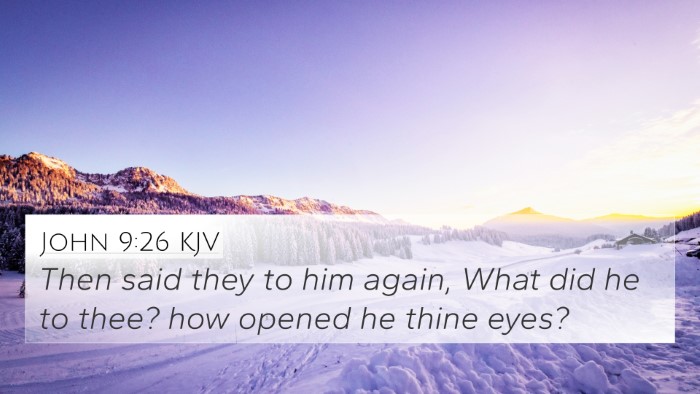Understanding John 9:15
John 9:15 states: "The Pharisees also asked him how he had received his sight. He said unto them, He put clay upon mine eyes, and I washed, and do see." This verse is part of a larger narrative where Jesus heals a man born blind. This miraculous healing not only demonstrates Jesus's divine power but also serves as a confrontation between Jesus and the religious leaders of the time, highlighting their skepticism and moral blindness.
Key Themes and Insights
-
Miraculous Healing: The act of healing the blind man emphasizes Jesus’s role as a healer and a transformer of lives. Commentators note that such miracles serve as evidence of His divine authority.
-
Role of Faith: The man's response reflects an essential aspect of Christian faith. His healing comes as a result of his obedience in following Jesus's instructions.
-
Conflict with Religious Authority: The repeated questioning by the Pharisees indicates their disbelief and serves as a critique of their spiritual blindness.
-
Symbolism of Sight and Blindness: This miracle serves as a dual metaphor; physical sight represents spiritual illumination, while blindness illustrates the refusal to accept truth.
-
Testimony of the Healed: The man’s straightforward testimony serves as a model for witnessing. His simplicity in recounting the miracle stands in contrast to the complex debates of the Pharisees.
-
Obedience and Action: The commands given (to wash in the Pool of Siloam) highlight that faith in Jesus often requires action on the believer’s part.
-
Public Confession: The healed man does not shy away from declaring what Jesus has done for him, exemplifying the importance of openly sharing one's faith and experiences.
Bible Verse Cross-References
This verse connects with numerous other scriptures that deepen the understanding of the themes involved. Here are some Bible verse cross-references to consider:
- Isaiah 35:5-6: Prophecy regarding the coming of the Messiah, where the blind will see.
- John 8:12: Jesus as the light of the world, contrasting spiritual light with darkness.
- Mark 10:51-52: The healing of Bartimaeus, which echoes faith and the healing power of Christ.
- John 3:19-21: Discusses the theme of light versus darkness, pertinent to the blindness of the Pharisees.
- Psalm 146:8: The Lord opens the eyes of the blind, reinforcing God’s characteristic concern for the marginalized.
- Luke 4:18: Jesus's mission to proclaim sight to the blind, aligned with His ministry goals.
- Matthew 11:5: References to the works of Christ, including healing the blind, illustrating the fulfillment of prophetic words.
Comparative Bible Verse Analysis
In undertaking a comparative analysis, it’s vital to recognize the significance of the relationship between these verses. The concept of blindness is prevalent in both the Old and New Testaments. For instance, while Isaiah speaks of physical healing, John interprets this also in a spiritual light, where belief and recognition of Jesus as the Messiah are central.
Scriptural Cross-Referencing
Understanding John 9:15 through the lens of cross-referencing allows for a deeper comprehension of its theological implications. By considering other accounts of healing and interactions between Jesus and the religious elite, the reader can gain insights into how different scriptural narratives intertwine.
How to Use Bible Cross-References
Tools for Bible cross-referencing can enhance study methods significantly. Using a Bible concordance or cross-reference Bible study guide, believers can discover pertinent connections and themes in their readings. A systematic approach to finding cross-references will provide a enriched understanding of how the Bible's various parts converse with one another.
Conclusion
John 9:15 not only participates in a historical event but also commands a profound theological narrative, bridging Old Testament prophecy with New Testament fulfillment. The exploration of such interconnections presents an opportunity for effective Bible study, building a foundation for thematic explorations of faith, healing, and spiritual insight. By engaging with both the immediate narrative and the broader scriptural context, believers are encouraged to honor the transformative power of Christ while addressing their own spiritual sight.




